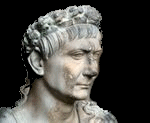
The year is 101A.D. The powerful Dacian king Decebalus threatens Rome, his army has defeated Roman forces under Domitian (81-96) and now threatens Trajan's Rome. Trajan (98-117) Emperor of Rome determined to put an end to the situation defeats Decebalus during the First Dacian War (101-102) and forces him to terms. In 105 Decebalus breaks the terms. Trajan embarks on a second campaign aimed at total conquest of the Dacian kingdom. It's now in 105 A.D. that II Traiana is born. The new Legion, named after the Emperors Father's Family, along with XXX Ulpia Victrix and Elements of other Roman forces and Allies, bridge the Danube and Trajan wins the Second Dacain War (105-106). Dacia becomes a Roman Province and for it's Strength and Fortitude during the campaign, II Traiana is given the Moniker Fortis, the strong Legion of Trajan and for it's emblem the Demi-God Hercules. For the last years of Trajan's life, the Emperor and his Legions lay siege to Parthia. After taking the Capital and bathing in the Persian Gulf the Emperor dies and the new Legion is sent to the troublesome Province of Judea.
Hadrian (117-138) becomes Emperor and in 125 the Legion is tranfered to Nicopolis a few miles Northeast of Alexandria where it shared a base with XXII Deiotariana. Soon afterwards in 130 the Jews revolt and destroy XXII Deiotariana, a Detachment from II Traiana is sent to Judea and help end the revolt. In 194, Pescennius Niger, governer of Syria rebelled with support of amoung others, Legio II Traiana. In the day's before the final battle the Legion changed sides and vowed fidelity to Septimius Severus. This would prove to be decisive for Pescennius defeat. At the start of the 3rd Century the Legion is involved in Caracalla's Campaign against Germanic tribes and is given the Cognomen Germanica. Still in Alexandria in 296, Diocletian (284-305) reorganizes and reinforces the Garrision with a second Legion, III Diocletiana. Two years later it fights the Moors in Mauretania. The Legion was still in the west of Lower Egypt in the 5th Century.

